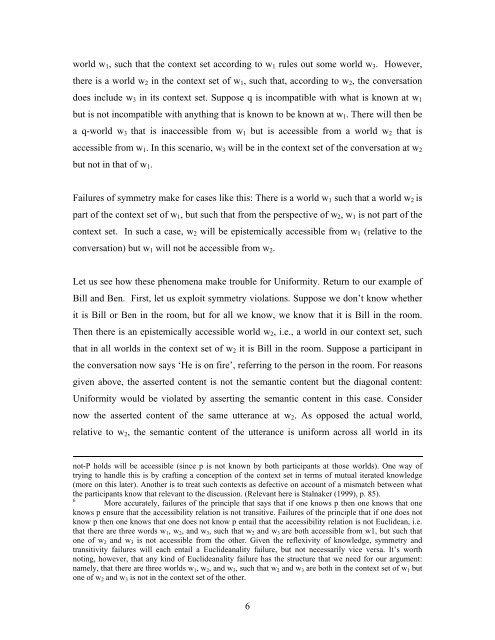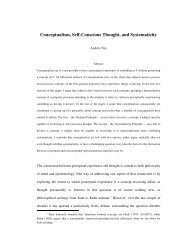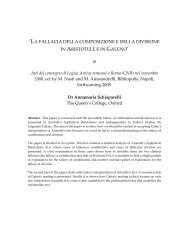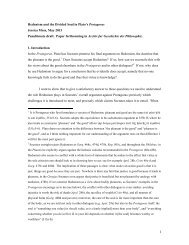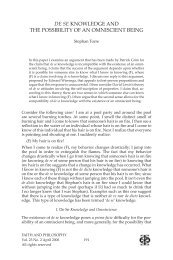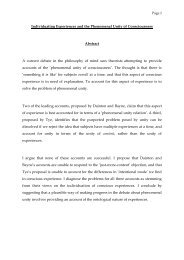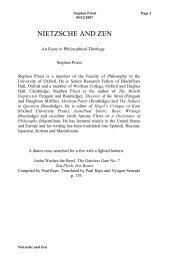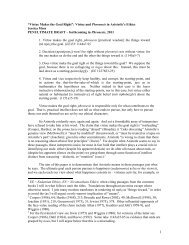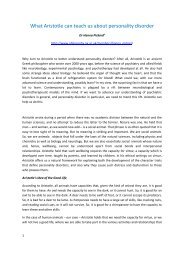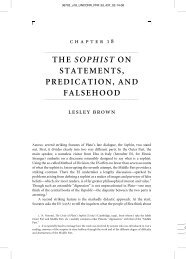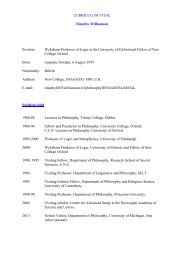In 'Assertion', Robert Stalnaker distinguishes between the sema
In 'Assertion', Robert Stalnaker distinguishes between the sema
In 'Assertion', Robert Stalnaker distinguishes between the sema
You also want an ePaper? Increase the reach of your titles
YUMPU automatically turns print PDFs into web optimized ePapers that Google loves.
world w 1 , such that <strong>the</strong> context set according to w 1 rules out some world w 3 . However,<br />
<strong>the</strong>re is a world w 2 in <strong>the</strong> context set of w 1 , such that, according to w 2 , <strong>the</strong> conversation<br />
does include w 3 in its context set. Suppose q is incompatible with what is known at w 1<br />
but is not incompatible with anything that is known to be known at w 1 . There will <strong>the</strong>n be<br />
a q-world w 3 that is inaccessible from w 1 but is accessible from a world w 2 that is<br />
accessible from w 1 . <strong>In</strong> this scenario, w 3 will be in <strong>the</strong> context set of <strong>the</strong> conversation at w 2<br />
but not in that of w 1 .<br />
Failures of symmetry make for cases like this: There is a world w 1 such that a world w 2 is<br />
part of <strong>the</strong> context set of w 1 , but such that from <strong>the</strong> perspective of w 2 , w 1 is not part of <strong>the</strong><br />
context set. <strong>In</strong> such a case, w 2 will be epistemically accessible from w 1 (relative to <strong>the</strong><br />
conversation) but w 1 will not be accessible from w 2 .<br />
Let us see how <strong>the</strong>se phenomena make trouble for Uniformity. Return to our example of<br />
Bill and Ben. First, let us exploit symmetry violations. Suppose we don’t know whe<strong>the</strong>r<br />
it is Bill or Ben in <strong>the</strong> room, but for all we know, we know that it is Bill in <strong>the</strong> room.<br />
Then <strong>the</strong>re is an epistemically accessible world w 2 , i.e., a world in our context set, such<br />
that in all worlds in <strong>the</strong> context set of w 2 it is Bill in <strong>the</strong> room. Suppose a participant in<br />
<strong>the</strong> conversation now says ‘He is on fire’, referring to <strong>the</strong> person in <strong>the</strong> room. For reasons<br />
given above, <strong>the</strong> asserted content is not <strong>the</strong> <strong>sema</strong>ntic content but <strong>the</strong> diagonal content:<br />
Uniformity would be violated by asserting <strong>the</strong> <strong>sema</strong>ntic content in this case. Consider<br />
now <strong>the</strong> asserted content of <strong>the</strong> same utterance at w 2 . As opposed <strong>the</strong> actual world,<br />
relative to w 2 , <strong>the</strong> <strong>sema</strong>ntic content of <strong>the</strong> utterance is uniform across all world in its<br />
not-P holds will be accessible (since p is not known by both participants at those worlds). One way of<br />
trying to handle this is by crafting a conception of <strong>the</strong> context set in terms of mutual iterated knowledge<br />
(more on this later). Ano<strong>the</strong>r is to treat such contexts as defective on account of a mismatch <strong>between</strong> what<br />
<strong>the</strong> participants know that relevant to <strong>the</strong> discussion. (Relevant here is <strong>Stalnaker</strong> (1999), p. 85).<br />
6<br />
More accurately, failures of <strong>the</strong> principle that says that if one knows p <strong>the</strong>n one knows that one<br />
knows p ensure that <strong>the</strong> accessibility relation is not transitive. Failures of <strong>the</strong> principle that if one does not<br />
know p <strong>the</strong>n one knows that one does not know p entail that <strong>the</strong> accessibility relation is not Euclidean, i.e.<br />
that <strong>the</strong>re are three words w 1 , w 2 , and w 3 , such that w 2 and w 3 are both accessible from w1, but such that<br />
one of w 2 and w 3 is not accessible from <strong>the</strong> o<strong>the</strong>r. Given <strong>the</strong> reflexivity of knowledge, symmetry and<br />
transitivity failures will each entail a Euclideanality failure, but not necessarily vice versa. It’s worth<br />
noting, however, that any kind of Euclideanality failure has <strong>the</strong> structure that we need for our argument:<br />
namely, that <strong>the</strong>re are three worlds w 1 , w 2 , and w 3 , such that w 2 and w 3 are both in <strong>the</strong> context set of w 1 but<br />
one of w 2 and w 3 is not in <strong>the</strong> context set of <strong>the</strong> o<strong>the</strong>r.<br />
6


